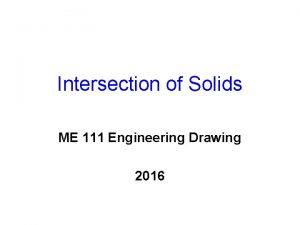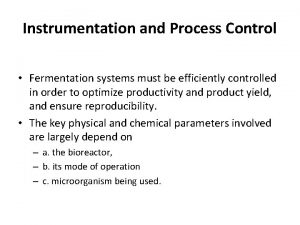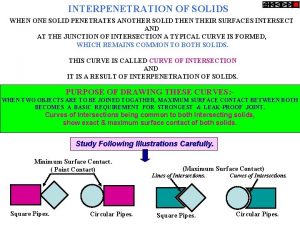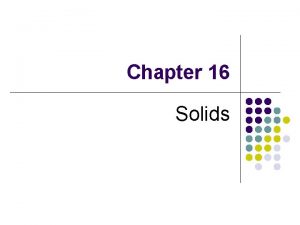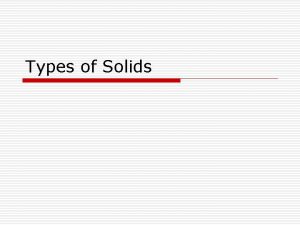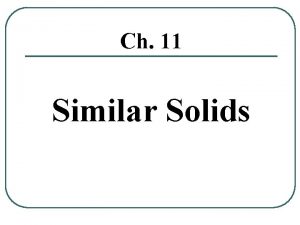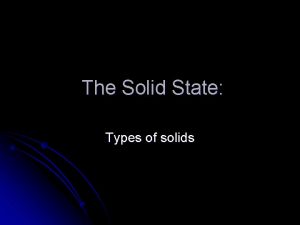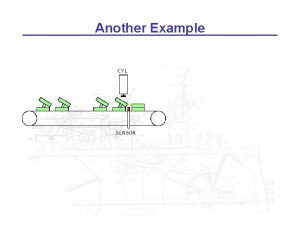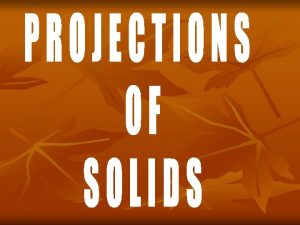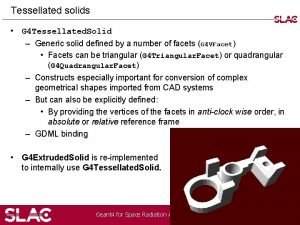INTERPENETRATION OF SOLIDS WHEN ONE SOLID PENETRATES ANOTHER















- Slides: 15

INTERPENETRATION OF SOLIDS WHEN ONE SOLID PENETRATES ANOTHER SOLID THEN THEIR SURFACES INTERSECT AND AT THE JUNCTION OF INTERSECTION A TYPICAL CURVE IS FORMED, WHICH REMAINS COMMON TO BOTH SOLIDS. THIS CURVE IS CALLED CURVE OF INTERSECTION AND IT IS A RESULT OF INTERPENETRATION OF SOLIDS. PURPOSE OF DRAWING THESE CURVES: WHEN TWO OBJECTS ARE TO BE JOINED TOGATHER, MAXIMUM SURFACE CONTACT BETWEEN BOTH BECOMES A BASIC REQUIREMENT FOR STRONGEST & LEAK-PROOF JOINT. Curves of Intersections being common to both Intersecting solids, show exact & maximum surface contact of both solids. Study Following Illustrations Carefully. Minimum Surface Contact. ( Point Contact) Square Pipes. Circular Pipes. (Maximum Surface Contact) Lines of Intersections. Square Pipes. Curves of Intersections. Circular Pipes.

SOME ACTUAL OBJECTS ARE SHOWN, SHOWING CURVES OF INTERSECTIONS. BY WHITE ARROWS. A machine component having two intersecting cylindrical surfaces with the axis at acute angle to each other. A Feeding Hopper In industry. An Industrial Dust collector. Intersection of two cylinders. Forged End of a Connecting Rod. Two Cylindrical surfaces. Intersection of a Cylindrical main and Branch Pipe. Pump lid having shape of a hexagonal Prism and Hemi-sphere intersecting each other.

FOLLOWING CASES ARE SOLVED. REFFER ILLUSTRATIONS AND NOTE THE COMMON CONSTRUCTION FOR ALL 1. CYLINDER TO CYLINDER 2. 2. SQ. PRISM TO CYLINDER 3. CONE TO CYLINDER 4. TRIANGULAR PRISM TO CYLNDER 5. SQ. PRISM TO SQ. PRISM 6. SQ. PRISM TO SQ. PRISM ( SKEW POSITION) 7. SQARE PRISM TO CONE ( from top ) 8. CYLINDER TO CONE COMMON SOLUTION STEPS One solid will be standing on HP Other will penetrate horizontally. Draw three views of standing solid. Name views as per the illustrations. Beginning with side view draw three Views of penetrating solids also. On it’s S. V. mark number of points And name those(either letters or nos. ) The points which are on standard generators or edges of standing solid, ( in S. V. ) can be marked on respective generators in Fv and Tv. And other points from SV should be brought to Tv first and then projecting upward To Fv. Dark and dotted line’s decision should be taken by observing side view from it’s right side as shown by arrow. Accordingly those should be joined by curvature or straight lines. Note: Incase cone is penetrating solid Side view is not necessary. Similarly in case of penetration from top it is not required.

A vertical cylinder of 60 mm diameter is penetrated by another cylinder of 40 mm diameter, the axis of which bisects the axis of vertical cylinder. Draw projections showing curves of intersection. 1’ 2’ 12’ 3’ 11’ 4’ 10’ 5’ 9’ 6’ 8’ 7’ p 12 p 1 p 2 p 11 p 3 p 10 p 4 p 9 p 5 p 8 p 6 p 7 q 1 q 2 q 12 q 3 q 11 q 4 q 10 q 5 q 9 q 6 q 8 1’ 2’ 12’ 3’ 11’ 4’ 10’ 5’ 9’ 6’ 8’ 7’ q 7 10’ 9’ 11’ 8’ 12’ 7’ 1’ 6’ 2’ 5’ 3’ 4’ Steps: 1. Draw the TV and FV of the vertical cylinder of 60 mm dia. and 100 mm length. Then also draw its side view. 2. Draw a circle of 40 mm dia in the side view with centre at the mid point of the axis. Then divide this circlie in 12 equal parts, number them, first in the SV then in FV & TV. 12” 1” 2” 11” 3” 4” 10” 5” 9” 8” 7” 6” CASE 1. CYLINDER STANDING & CYLINDER PENETRATING

A vertical cylinder of 60 mm diameter is penetrated by another Steps: 1. cylinder of 40 mm diameter, the axis of which is parallel to both Draw the TV and FV of the vertical cylinder of 60 mm dia. and 100 mm length. the HP and the VP. The axis of two cylinders are 9 mm apart. Draw projections showing curves of intersection. 9 1’ 2’ 12’ p 12 3’ 11’ p 11 4’ 10’ p 10 5’ 9’ p 9 p 8 6’ 8’ 7’ p 2 q 3 p 4 p 6 p 7 p 5 q 2 q 4 q 5 q 12 1’ 2’ 12’ q 11 3’ 11’ q 10 4’ 10’ q 9 q 8 5’ 9’ q 6 q 7 6’ 8’ 7’ 10 9 11 8 12 7 1 6 2 5 3 4 12” 1” 2” 11” 3” 4” 10” 5” 9” 8” 7” 6”

A cylinder of 50 mm diameter of base and 60 mm long axis is standing on its base, is penetrated by another cylinder of same size, with the axis of penetrating cylinder parallel to both HP and VP. The axis of two cylinders bisect each other. Draw projections showing curves of intersection. 1’ p 1 q 1 p 12 2’ 12’ p 2 3’ 11’ p 11 q 2 p 9 5’ 9’ 6’ 8’ p 7 p 6 p 8 p 5 3’ 11’ q 11 4’ 10’ q 5 q 9 q 6 12” 2’ 12’ q 12 p 10 p 4 4’ 10’ 7’ q 3 p 3 1’ 5’ 9’ q 8 1” 2” 3” 11” 4” 10” 5” 9” 6’ 8’ 7’ q 7 10 10 9 11 8 12 7 1 6 2 5 3 4 4 8” 7” 6”

A cylinder of 50 mm diameter of base and 60 mm long axis is standing on its base, is penetrated by another cylinder of same size, with the axis of penetrating cylinder parallel to both HP and VP. The axis of two cylinders are 9 mm apart. Draw projections showing curves of intersection. 1’ 2’ 12’ p 12 p 11 3’ 11’ 4’ 10’ p 10 5’ 9’ 6’ 8’ 7’ p 6 p 7 q 12 q 11 1’ q 10 4’ 10’ 5’ 9’ q 6 q 8 12” 2’ 12’ 3’ 11’ q 9 p 8 9 q 1 p 1 6’ 8’ 7’ q 7 10 10 9 11 8 12 7 1 6 2 5 3 4 4 1” 2” 3” 11” 4” 10” 5” 9” 8” 7” 6”

Problem: A cylinder 50 mm dia. and 70 mm axis is completely penetrated by another of 40 mm dia. and 70 mm axis horizontally Both axes intersect & bisect each other. Draw projections showing curves of intersections. 2’ 4’ 1’ 3’ 1” 3” 4” a’ h” b” g” d’f’ a’ X 2” a” b ’h’ c’g’ CASE 1. CYLINDER STANDING & CYLINDER PENETRATING c” d” f” e” Y 4 3 1 2

Problem: A cylinder 50 mm dia. and 70 mm axis is completely penetrated by a square prism of 25 mm sides. and 70 mm axis, horizontally. Both axes Intersect & bisect each other. All faces of prism are equally inclined to Hp. Draw projections showing curves of intersections. 2’ 4’ 1’ 4” 3’ a’ a’ b’ d’ c’ X 2” a” d” b’ d’ c’ 1” 3” CASE 2. CYLINDER STANDING & SQ. PRISM PENETRATING b” c” Y 4 3 1 2

CASE 3. CYLINDER STANDING & CONE PENETRATING Problem: A cylinder of 80 mm diameter and 100 mm axis is completely penetrated by a cone of 80 mm diameter and 120 mm long axis horizontally. Both axes intersect & bisect each other. Draw projections showing curve of intersections. 7’ 6’ 8’ 1’ 5’ 2’ 4’ 3’ X Y 1 28 37 46 5

Problem: A sq. prism 30 mm base sides. and 70 mm axis is completely penetrated CASE 4. by another square prism of 25 mm sides. and 70 mm axis, horizontally. Both axes. SQ. PRISM STANDING Intersects & bisect each other. All faces of prisms are equally inclined to Vp. & Draw projections showing curves of intersections. SQ. PRISM PENETRATING 2’ 4’ 1’ 3’ 4” a’ a’ b’ d’ 1” 3” a” d” b’ d’ c’ c’ X 2” b” c” Y 4 3 1 2

Problem: A cylinder 50 mm dia. and 70 mm axis is completely penetrated by a triangular prism of 45 mm sides. and 70 mm axis, horizontally. One flat face of prism is parallel to Vp and Contains axis of cylinder. Draw projections showing curves of intersections. CASE 5. CYLINDER STANDING & TRIANGULAR PRISM PENETRATING 2’ 4’ 1’ 3’ a a 4” 1” 3” a b b b 2” c c d e X d e f 4 3 1 2 f Y

CASE 6. SQ. PRISM STANDING & SQ. PRISM PENETRATING (300 SKEW POSITION) Problem: A sq. prism 30 mm base sides. and 70 mm axis is completely penetrated by another square prism of 25 mm side s. and 70 mm axis, horizontally. Both axes Intersect & bisect each other. Two faces of penetrating prism are 300 inclined to Hp. Draw projections showing curves of intersections. 2’ 4’ 1’ 3’ a’ 1” 3” 4” f” f’ 2” a” e” e’ b” b’ c’ d” c” d’ 300 X 4 3 1 2 Y

CASE 7. CONE STANDING & SQ. PRISM PENETRATING (BOTH AXES VERTICAL) 2’ 1’ 3’ 5’ 4’ 6’ X a’ b’h’ c’g’ d’f’ Y e’ g 8 h 9 f 7 10 6 1 a e 2 5 3 4 b d c 5 mm OFF-SET Problem: A cone 70 mm base diameter and 90 mm axis is completely penetrated by a square prism from top with it’s axis // to cone’s axis and 5 mm away from it. a vertical plane containing both axes is parallel to Vp. Take all faces of sq. prism equally inclined to Vp. Base Side of prism is 0 mm and axis is 100 mm long. Draw projections showing curves of intersections.

Problem: A vertical cone, base diameter 75 mm and axis 100 mm long, CASE 8. is completely penetrated by a cylinder of 45 mm diameter. The axis of the CONE STANDING cylinder is parallel to Hp and Vp and intersects axis of the cone at a point & 28 mm above the base. Draw projections showing curves of intersection. CYLINDER PENETRATING o’ o” 1 a’ 2 8, 2 3 3 7, b’h’ 8 c’g’ d’f’ e’ g” f e b d c 4 5 5 a 2 3 6 g h 1 7 64 4 5 X 1 g”h” a”e” b”d” c” Y
 When a solid completely penetrates another solid
When a solid completely penetrates another solid Interpenetration of solids
Interpenetration of solids Interpenetration of solids in engineering drawing pdf
Interpenetration of solids in engineering drawing pdf Which of the following sensor penetrates into the fermenter
Which of the following sensor penetrates into the fermenter Conversion of solid from one shape to another
Conversion of solid from one shape to another The harp harris burdick
The harp harris burdick Plan of drawing shows
Plan of drawing shows Egd interpenetration and development
Egd interpenetration and development Crystalline solid and amorphous solid
Crystalline solid and amorphous solid Solid solution
Solid solution Covalent molecular and covalent network
Covalent molecular and covalent network Crystallography types
Crystallography types Crystalline solid
Crystalline solid Crystalline solid and amorphous solid
Crystalline solid and amorphous solid Law of constancy of interfacial angle
Law of constancy of interfacial angle Evaporation mixture examples
Evaporation mixture examples


